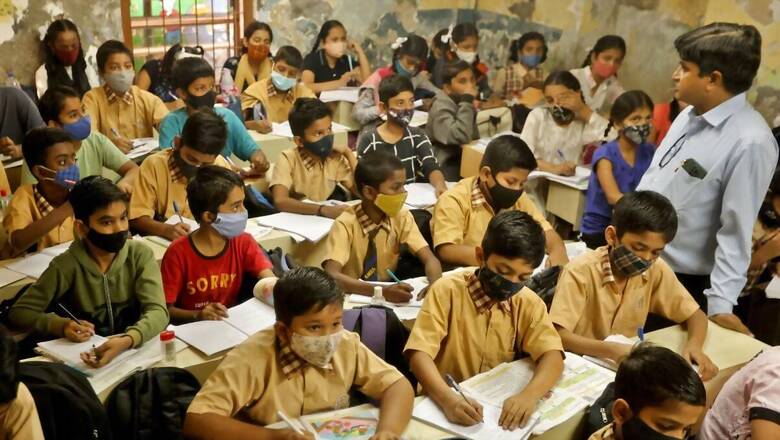
views
Despite two harsh years of school closures, India has successfully managed to get students back to school. This achievement is a result of several policies in the last 70 years that have focused on ensuring India has high enrollment and low dropout rates. This includes initiatives such as the Mid-Day Meal scheme, the provision of free books, and the Rashtriya Madhyamik Shiksha Abhiyan.
While this in itself is a huge success, with school enrollment standing at 26.5 crore children in FY22, what has not been a focus until the last few years is on the learning outcomes. A significant indicator of this neglect is the poor rate of Foundational Literacy and Numeracy (FLN) skills in India. FLN skills serve as the cornerstone upon which a child’s educational journey is built. According to a World Bank assessment, in India, around 50 per cent of children lack foundational learning, and by the time they reach grade 5, it becomes difficult for them to grasp the teaching and learn as per the grade level.
Furthermore, ASER 2022 reveals that only 25.6 per cent of learners from grade 5 in rural India are able to do basic division. With India’s digital penetration and data reach growing at an exponential rate, it would be a missed opportunity if we do not embrace it for building foundational blocks that can tackle the larger learning poverty problem at hand.
EdTech: A step towards improvement, but not all technology helps impact learning
Since the beginning of the Covid-19 pandemic, there has been a growing acknowledgement of educational technology (EdTech) solutions as potent means to enrich learning experiences. Despite being viewed as promising avenues, caution is warranted, as evidenced by various studies. The Organisation for Economic Co-operation and Development (OECD) highlights a lack of correlation between national expenditures on information and communications technology (ICT) and the proficiency of 15-year-olds in math, science, and reading.
Moreover, educational content often fails to resonate with students due to a lack of cultural contextualisation, resulting in limited comprehension and retention. Many EdTech platforms prioritise content digitisation over understanding the pedagogical principles underlying children’s learning processes. Nevertheless, there exists a significant opportunity to harness the momentum surrounding EdTech in a meaningful manner.
Embracing PAL Solutions with AI
In Indian classrooms, there exists a notable diversity among students, leading to varying learning levels within the same setting. This diversity poses a challenge for educators to effectively cater to individual needs, even for the most skilled teachers. Consequently, many students struggle to keep pace with grade-level expectations, often resulting in dropout rates. Teaching at the Right Level (TaRL) has emerged as a successful strategy for addressing these learning gaps and bringing students up to par with expected standards.
To enhance student learning outcomes, especially for those lagging behind, computer-assisted personalised learning solutions show great promise. Among these, Personalised Adaptive Learning (PAL) software stands out, offering tailored and differentiated learning experiences within the classroom without disrupting the class dynamics. PAL solutions adopt a student-centric approach, adjusting teaching methods, content, and pacing to suit each student’s unique learning requirements. This personalised approach has been shown to significantly enhance learning outcomes and mitigate learning level discrepancies.
The integration of Artificial Intelligence (AI) further augments the development of PAL solutions. AI technologies contribute to gamifying education, making learning more interactive and enjoyable. Automated grading systems, powered by AI algorithms, provide instantaneous feedback on assignments, quizzes, and exams, fostering a more efficient learning environment.
Moreover, the majority of PAL solutions are now accessible via mobile devices, aligning with India’s rapid growth in data availability and mobile penetration. Even with just 45 minutes to 1 hour of daily PAL software usage on a parent’s mobile phone, a child can experience significant improvements in their learning levels. Encouraging parent and community involvement can further enhance learning outcomes by enabling students to continue learning at home and during holidays, thus minimising the risk of significant learning gaps.
Teachers can do anything. PAL helps them do it better
The predictive analytics capabilities of PAL combined with AI facilitate the early detection of learning difficulties. Through analysing patterns in student performance data, AI algorithms can anticipate potential challenges or areas of struggle for students. These algorithms typically align with the curriculum, allowing teachers to manage topic activation and utilise the data to gauge student progress and identify learning gaps. This empowers teachers to better tailor classroom practices and instructions to meet the needs of their students. It’s essential to recognise that no technology can replace teachers; instead, these solutions are designed to support teachers in enhancing their effectiveness.
The Time is Now
In recent years, there has been a notable shift in the approach of several state governments and national authorities towards embracing and endorsing PAL for learning. The National Curriculum Framework for School Education 2023 (NCFSE) underscores the significance of personalised learning in the educational landscape. Notably, in 2022, Haryana emerged as the pioneering state to adopt tablet-based personalised learning, albeit limited to grades 10-12. This initiative marked a progressive step forward in the realm of education.
India’s escalating expenditure on education underscores a growing commitment to improving the quality of learning. However, merely increasing investments is not sufficient; they must be leveraged intelligently. Sustainable improvements in educational outcomes necessitate ongoing innovation and the implementation of smarter solutions over time. Without continuous evolution and adaptation, the desired transformation in educational outcomes will remain elusive. Therefore, it’s imperative to prioritise innovation and the adoption of cutting-edge solutions to propel India’s education system towards greater effectiveness and inclusivity.
Mahek Nankani is a Development Professional. Views expressed in the above piece are personal and solely that of the author. They do not necessarily reflect News18’s views.















Comments
0 comment